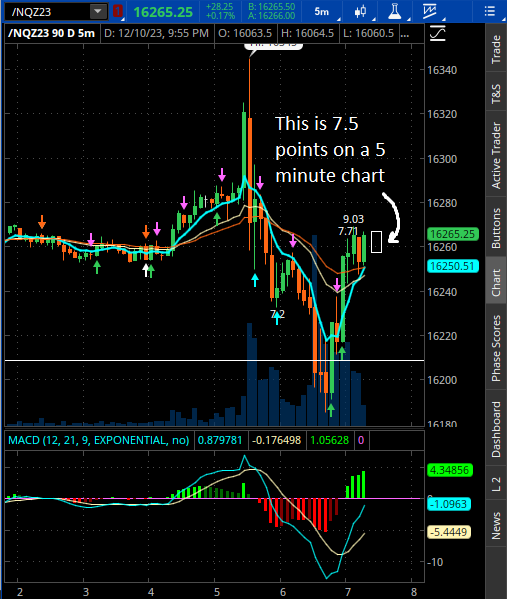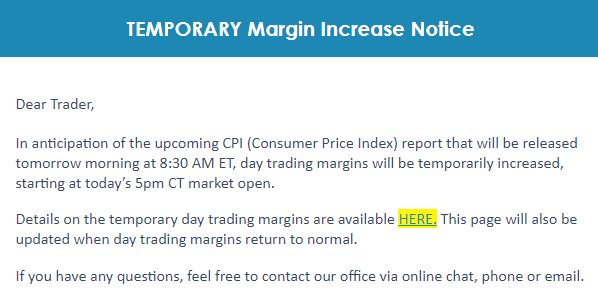In addition, any charts for financial instruments in this article are for education only. The examples shown here do not constitute trading advice or a solicitation to buy or sell any financial instrument. Past performance is not necessarily an indication of future performance.
If you would like to learn more, please read this Disclaimer for details.
Why are more traders pursuing funded futures accounts instead of working for weeks or months and funding themselves? If you’re already experienced with trading futures, and simply don’t have a ton of capital, you may have considered the funded trading programs available today. If you haven’t, I strongly recommend that you do.
These programs are such a game changer that I feel like they will want to impose new restrictions on retail traders somehow in the near future. That’s how good this situation actually is for futures traders – it still feels too good to be true.
But you might not be convinced yet. For whatever reason, a lot of traders are still quite negative about the opportunity that exists. I suspect that it has much to do with either an inability to trade well consistently, or they have so much money that they’ve forgotten what it’s like to need more capital to trade comfortably.
There are several major advantages to having a funded futures account over trading your own, which I will go over below. If you decide that it’s not right for you, that’s always your choice. But keep an open mind, and you may be pleasantly surprised by the end of this article.
- Futures are better than stocks due to the increased leverage.
- The math works tremendously in your favor.
- You have the ability to trade full contracts, at all times.
- The stress relief might change your trading (and your life).
- The systems and rules force you to develop discipline as a trader.
- There’s no reason you can’t do both (or more).
- Are there more advantages I’ve missed? Let me know!
Futures are better than stocks due to the increased leverage.
The leverage in futures (and forex) is insane, allowing returns unlike anything outside of a GameStop type of situation in stocks.
By trading futures contracts, you can double or triple your money on a single day trade, without hunting for a new market everyday. In stocks, you’ll be very lucky to find something like that once a month.
The math works tremendously in your favor.
I’m going to use NQ (Nasdaq-100 Futures) and occasionally ES (S&P 500 Futures) as an example, because it’s what I trade.
The cost of a typical $50,000 evaluation account is about $150 per month (passing in the first month should be the goal), and provides traders with $2,500 drawdown.
If you hit the drawdown, you lose the account, so $2,500 is really the number you should be looking at, not $50,000.
This means that you are voluntarily taking a $150 loss up front, for the chance to acquire funding worth $2,500. I’m not too familiar with the old school prop firms, but I get the feeling that traders weren’t able to trade full futures contracts this easily.
There’s so much to unpack with the futures funded programs, but let’s focus on the cost for now. If you are trading your own small account (a few thousand dollars), you will most likely be limited to trading 1-2 e-minis. If you want to use more size, you will either not meet the margin requirement, or you will be unable to trade after just a few losses.
If you’ve traded NQ before, you probably already know that a small loss in futures can easily be over $150 per contract. This is just 7.5 points on NQ (3 points on ES), a market where there are frequent 5 point swings in less than 10 seconds.

Have you had a month where you suffered more than $150 in losses while trading futures? Then you’ve had a month that could have covered an evaluation, where you could trade for the entire month and never risk any of your capital beyond $150.
Even if you have a catastrophic failure during either the evaluation phase or with the funded account, there is no consequence besides losing the account (and the damage to your pride, which you probably needed anyway). So if you’ve lost $1,200 in a month (or a day), subsequently blowing a personal account, think about it this way. Your loss was the equivalent of burning 8 separate $50,000 ($2,500 drawdown) prop firm accounts at the same time.
No matter how you look at it, the math points to acquiring funding, instead of trading futures on your own.
You have the ability to trade full contracts, at all times.
Have you ever gotten this e-mail from your futures broker?

I remember clearly how it felt to trade in March 2020, during the first wave of Covid-19. The market was extremely volatile, and all brokers quickly raised the NQ margins to $20,000 per contract. Most of you would have to trade the micros (and those margins sometimes rose to $2,000!), reducing your potential profits by 90%.
This isn’t to say that there aren’t some restrictions imposed on traders with funded accounts – there’s definitely a different system to learn and adapt to. However, for the most part, nothing will limit your ability to place trades. On a normal account, higher margins can take you out of the market for an entire day or week.
But this same issue can arise in normal market conditions too. Think about what happens when you are facing a drawdown. If your $2,500 personal account drops to below $1,000, you’re done trading full contracts.
However, on a futures funded account, you’ll have just $500 of drawdown left. Yet, you’ll be able to trade full contracts, with the same size as you would at $2,500.
Remember that even if there’s increased volatility, or you find yourself in a hole, the market is still going to produce high quality setups whenever it wants to. Whether you can trade or not is entirely dependent on you and your situation. With a funded account, you’re going to be able to able to take advantage of these setups with the same size just as you normally would. Are you starting to see how powerful a funded account really is?
Apex Trader Funding is one firm which allows 10 contracts on a $50,000 account, but the typical size you’ll see on a similar account is 6-8 contracts. You can learn all about the various accounts and their costs here.
The stress relief might change your trading (and your life).
Debatably the best advantage on this list is the effect on your stress levels. This might not apply to you, but I know it’s something that many traders really struggle with, and often overlook.
When I was struggling to find consistency in trading my own account, I was often stressed out by big losses. I would get frustrated when my bad habits kept getting in the way of long-term profitability. For me, this was usually impulsively entering trades outside of my system, one of many types of overtrading and impatience.
After burning a lot of money and blowing up several accounts, I started to take advantage of the opportunity with prop firms. I noticed my trading improving immensely in a short period of time.
This was not because of any change to my strategy, but because of a shift in my overall approach. Trading with certain prop firms encouraged me to trade less per day, as they don’t reward more trades or more hours spent in front of the screen. I could achieve the same end result (a funded account) by placing one small to mid-sized trade for 30 minutes per day, if I wanted to. Less hours equals less work, which usually means less stress.
Most importantly, by knowing that there was no risk to my own capital, I was free to trade with confidence and try new things. As a result, my strategy ended up getting even better, and the experience I’ve gained at a fraction of the cost has been immense.
I now view these programs as the best way for traders to paper trade. It’s demo trading with unlimited upside. There are no brokers that offer a demo account with the chance to acquire a live funded account with real profits – but that’s exactly what this can be for you.
The amount of stress that has been taken out of trading by knowing I am at no personal risk is immeasurable. I had originally planned to return to trading my own accounts after building up some capital, but with the profit split as favorable as it is now (typically 90% going to the trader), there’s just no reason to take on that stress ever again. It simply makes more sense to continue scaling up with these accounts and keep my personal account immune to market behavior.
The systems and rules force you to develop discipline as a trader.
I’ve covered the rules at each futures prop firm in-depth in a separate article, so I won’t talk about them here. But it’s likely that as you trade more within the system of one of these firms, you will realize that you’ve developed better discipline over time.
These rules force you to be aware of things that can be quite expensive on a personal account. If you leave positions open accidentally overnight, you fail the evaluation or lose your funded account. If you aren’t aware of an important news release and the market explodes in either direction, some firms will fail you for this as well.
The most frustrating feature at some firms is the trailing drawdown, and this is restrictive to more reckless traders. But even this seemingly annoying rule forces you to learn how to take profits more responsibly, and tune your trading more toward precision and away from gambling.
There are many important lessons to learn from trading within a system, which will be incredibly beneficial for beginner traders or traders that feel like they struggle to come up with a good structure themselves.
There’s no reason you can’t do both (or more).
So your pride tells you that there’s a huge disadvantage to not having 100% ownership of the account you trade. Why can’t you just trade your own account, and a funded futures account on the side?
Well, you can. There’s no restrictions whatsoever on what you do on your own while managing a funded futures account. In fact, it’s even encouraged at some firms to have multiple accounts with them. While this earns them more money from more evaluation costs, it also allows you to diversify your positions in a way. And the math works tremendously in your favor here, too.
Let’s say you’re trading 5 contracts, and you secure a great entry. With a normal $2,500 drawdown account, you would fail the account if NQ moved against you by 25 points ($20 x 25 points = $500, and $500 points for 5 contracts = $2500). But what if you used 5 funded accounts instead?
By spreading a 5 contract position into 1 contract on 5 separate accounts, you’re effectively utilizing a drawdown of $12,500 instead ($2,500 x 5). Now, for you to fail, NQ would have to move against you 125 points (on each account).
Of course, this kind of setup is more expensive because each account requires a separate evaluation cost. Beginners shouldn’t aim to trade multiple accounts, but it’s an option available to you when you’re ready. For the pros, this is a massive game-changer, provided you have a good enough strategy already.
This can massively improve your profitability and win rate, as you will be able to withstand more pullbacks on larger moves, without giving up profits by simply reducing size.

Leave a Reply